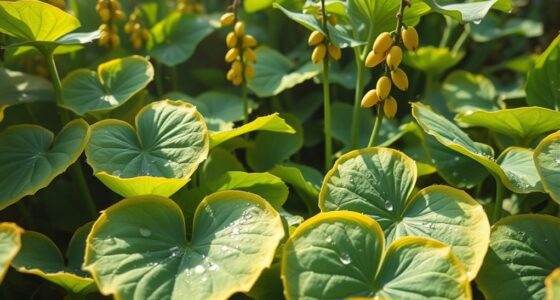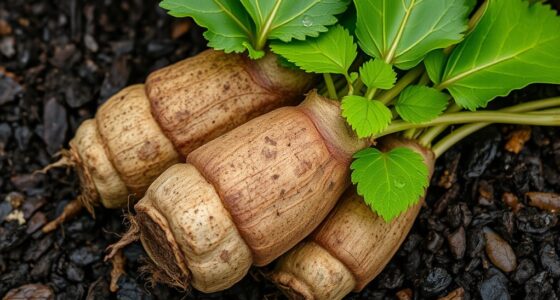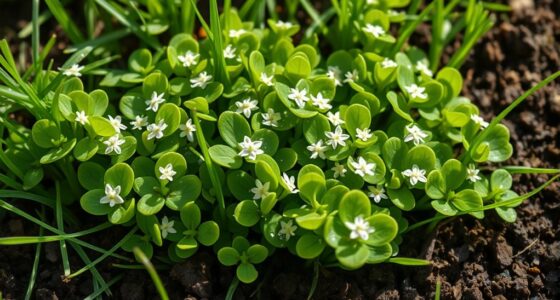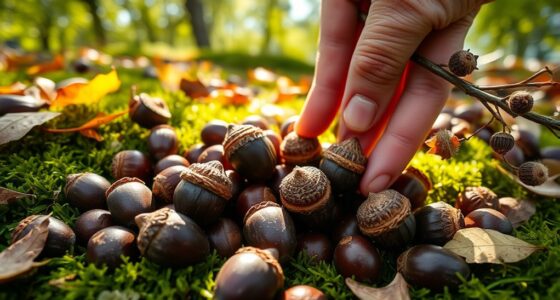To forage wood sorrel, look for its distinctive palmately compound leaves with three heart-shaped leaflets that fold along a central seam, usually in shady woods or moist areas. Spring to early summer is the best time, harvesting fresh, tender greens and flowers carefully by hand. This plant offers a bright, lemony flavor perfect for salads, beverages, or garnishes. Keep safety in mind by properly identifying and avoiding lookalikes—discover more tips and recipes ahead.
Key Takeaways
- Identify wood sorrel by its palmately compound, three-heart-shaped leaflets with a central crease and lemon-scented aroma when crushed.
- Forage during late spring to early summer (May–July) in shaded, moist habitats like woods, mossy areas, and disturbed sites.
- Harvest tender leaves, flowers, and seed pods carefully, wash thoroughly, and consume in moderation to avoid oxalic acid overload.
- Use lemon-flavored greens fresh in salads, infuse into teas, or make tangy syrups and sorbets to enjoy their bright citrus taste.
- Ensure proper identification and sustainable harvesting to enjoy the wild, lemon-flavored greens while protecting local ecosystems.
Recognizing Wood Sorrel in the Wild

To recognize wood sorrel in the wild, start by examining its distinctive leaves. You’ll notice their palmately compound structure, resembling three heart-shaped leaflets joined at the base. Each leaflet often has a central crease or seam, giving it a slightly folded appearance. The leaves are small, about an inch across, and typically a uniform green with no significant color variations. The plant usually grows 8 to 9 inches tall, with some species having delicate, thin stems. Look for the three-parted leaf arrangement, similar to clover, which makes identification easier. While the leaves are most noticeable, don’t forget to check for flowers later in the season—yellow, white, pink, or purple blooms can also help confirm you’ve found wood sorrel. Additionally, understanding its vibrational energy can help you connect with the plant on a deeper level and appreciate its natural properties. Recognizing the plant’s characteristic aroma can further assist in identification, as some species emit a subtle lemon scent when crushed. Paying attention to its plant habitat can also improve your chances of successful identification, since wood sorrel tends to favor shady, moist environments. Being aware of its edible nature can make foraging safer and more enjoyable. Furthermore, knowing about its conservation status can ensure responsible harvesting practices.
Best Seasons and Locations for Foraging
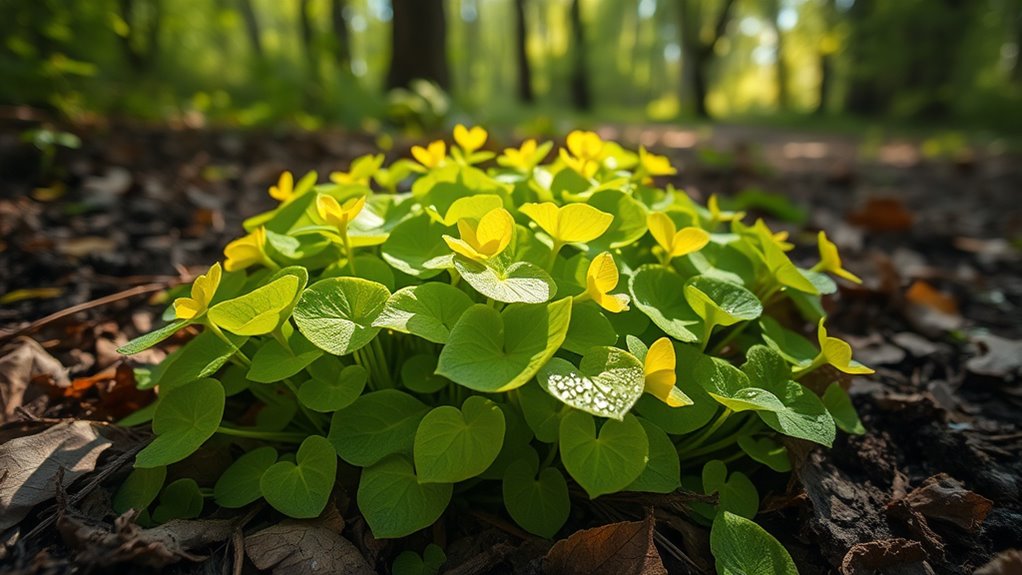
Wood sorrel is most readily foraged during its peak growing months, primarily from late spring to early summer. Between May and July, the leaves are larger and more flavorful, making it the ideal time to harvest. In some areas, you can find wood sorrel from May to September, and certain species grow year-round in suitable climates. Look for it in deciduous and coniferous woods, often in moss or on old stumps, as well as in suburban lawns and disturbed habitats. It adapts well to different terrains and moisture levels, thriving in shaded, moist environments. Your best bet is to scout these habitats during the late spring and early summer when the plants are at their most abundant and tastiest. Additionally, understanding the identification features of wood sorrel can help ensure you harvest the correct greens and safely enjoy their lemon-flavored taste. Being aware of digital literacy programs can also assist in safely identifying and foraging edible wild plants. Incorporating knowledge about plant ecology can further enhance your foraging success and safety. Recognizing the growth patterns of wood sorrel can also improve your ability to find it consistently across different locations. Moreover, paying attention to seasonal variations can help you identify the best times for foraging in your area.
Harvesting and Handling Tips

When harvesting wood sorrel, focus on selecting healthy, tender leaves for the best flavor and texture. Use your fingers to hand-pick leaves, being careful not to damage the plant or disturb the surrounding environment. Only take what you need, especially during peak season in spring and early summer, to guarantee sustainability. To ensure the plants remain healthy and productive, it’s helpful to understand self watering plant pots which can be used to cultivate herbs like wood sorrel indoors or in controlled environments. You can also harvest delicate stems and seed pods for use in dishes, but handle them gently. After harvesting, wash the leaves carefully with clean water to remove dirt or debris. If you’re not using them immediately, store the leaves in a cool, dry place or refrigerate to keep them fresh. Avoid chemicals and ensure correct identification to prevent consuming look-alikes or contaminated plants. Proper handling preserves flavor, texture, and plant health.
Culinary Uses and Flavor Pairings
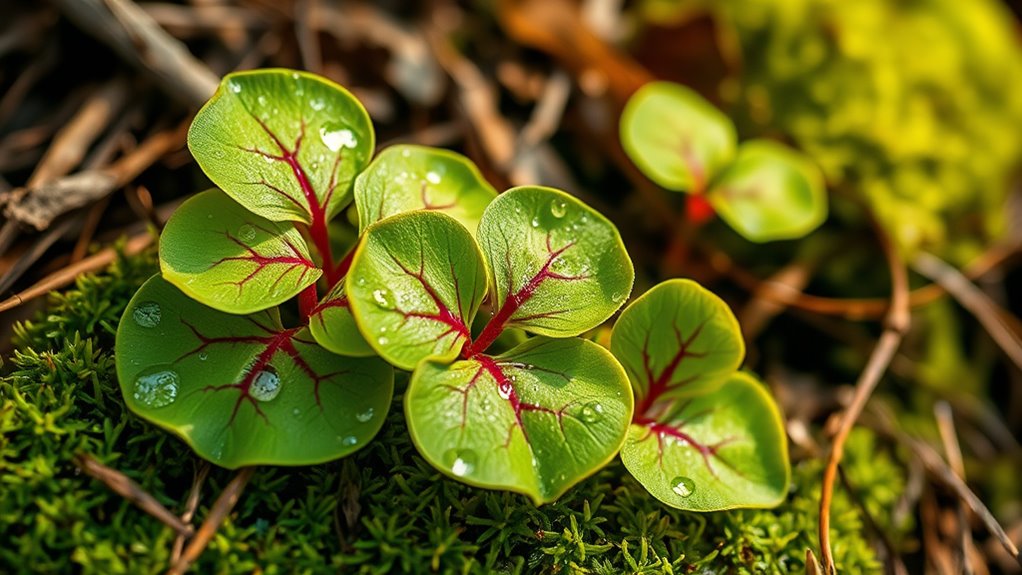
You can enjoy wood sorrel in a variety of culinary ways due to its bright, tangy flavor. Use it as a garnish in salads, adding a lively, lemony twist. Its leaves, flowers, and seed pods make quick, raw snacks perfect for trailside munching.
You can also incorporate it into main dishes like sautéed greens or soups, where its sour note enhances flavors. Infuse it into beverages, from hot teas to invigorating syrups, to add a unique tartness. Its natural acidity and vibrant flavor make it an excellent addition to dishes that benefit from a fresh, citrusy lift.
Its acidity pairs well with creamy cheeses like goat cheese, seafood, and roasted potatoes. You can also blend it into pestos or dressings for an extra zing. Incorporating native edible plants like wood sorrel can enrich your culinary repertoire and promote sustainable foraging.
Whether used raw or cooked, wood sorrel adds vibrant flavor and nutritional value, thanks to its vitamins C and A. The Vetted 2 months ago Vetted Electric Bike Conversion Kits demonstrate the importance of reliable, high-quality components, ensuring seamless performance—similar to how selecting fresh and flavorful greens enhances your culinary creations. Additionally, understanding electric bike costs can help you choose the best gear for sustainable transportation.
Safety Precautions When Consuming
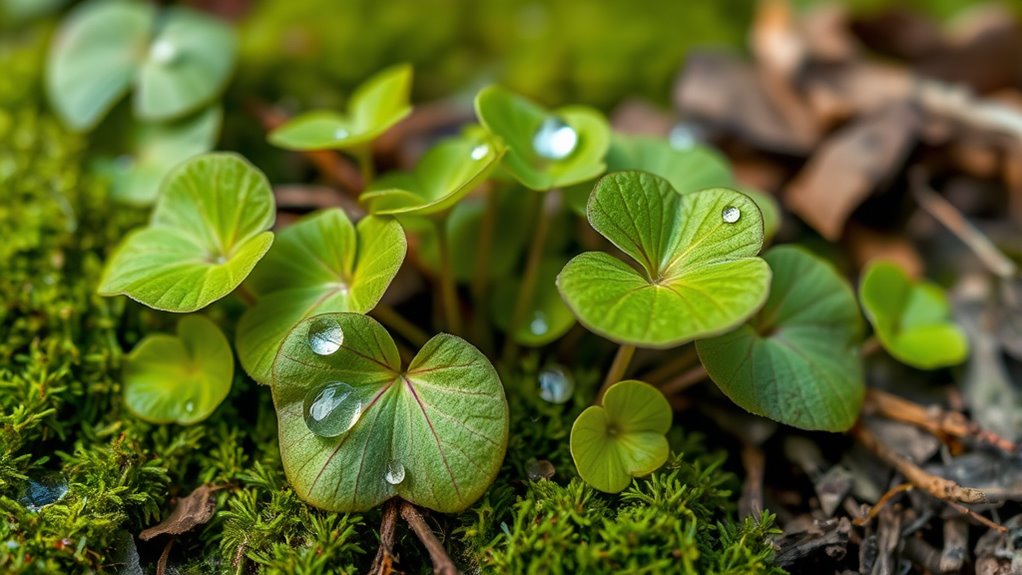
Proper identification and careful harvesting are essential to enjoying wood sorrel safely. Make sure you can distinguish it from toxic lookalikes, as misidentification can cause serious health issues.
When harvesting, only pick the young leaves, flowers, and immature seed pods, avoiding older, tougher stems for safety and better flavor. Correct identification is crucial to prevent consuming harmful plants. Additionally, understanding the cultural impact of technology on artistic expression can help you appreciate the broader context of natural and cultural environments.
Be aware of your environment—watch out for insects, wildlife, and other plants that could be harmful. Recognizing native plant species can assist in sustainable foraging and reduce the risk of accidental ingestion of toxic plants.
Always wash your foraged greens thoroughly to remove dirt, bacteria, and contaminants.
Consume wood sorrel in moderation—about 30 grams—to avoid excessive oxalic acid intake, which can harm your kidneys.
If you have allergies or pre-existing health conditions, especially kidney issues, consult a healthcare professional before eating.
Use gloves and tools to prevent injury and follow sustainable foraging practices.
Additionally, understanding the nutritional benefits of wild greens like wood sorrel can enhance your foraging experience and help you make informed dietary choices.
Being aware of potential toxicity and properly preparing wild greens ensures a safe and enjoyable foraging experience.
Different Varieties and Their Features
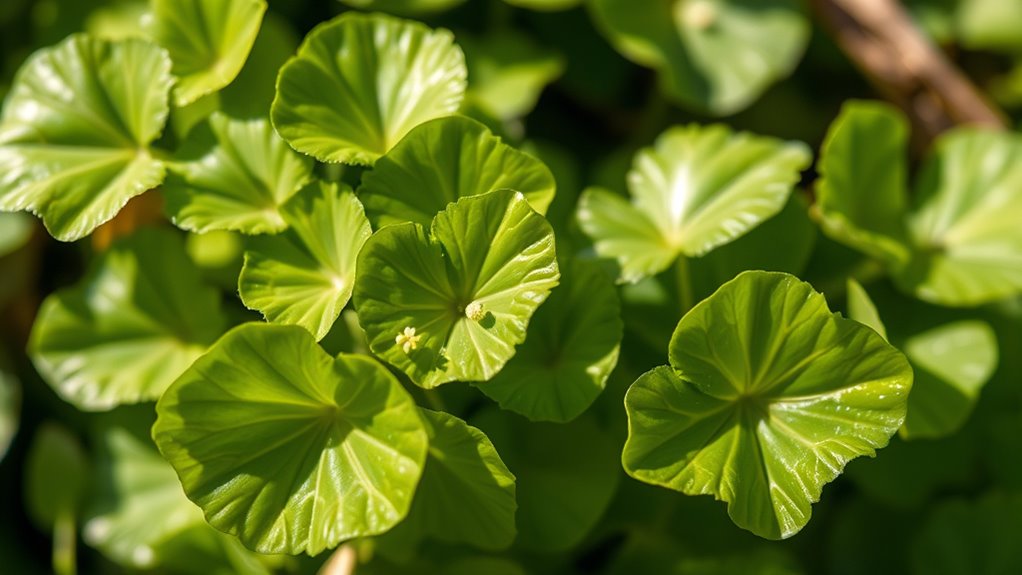
Different varieties of wood sorrel display a range of features that can help you identify and appreciate them. You’ll notice their heart-shaped trifoliate leaves, often growing in shaded deciduous woods and moist, well-drained soils. Transparency in affiliate relationships Flower colors vary from white and yellow to pink and lavender, blooming in spring. Some species, like *Oxalis stricta*, reach up to 9 inches tall with smooth or slightly hairy stems. Varieties differ in flavor—creeping types tend to be more sour and citrusy, while others like the *Pink Shamrock* feature pink or lavender flowers. The *Aureo-Reticulata* cultivar stands out with golden veins and pink blossoms. These plants are generally easy to grow, resistant to pests, and thrive in zones 4 to 10 with minimal maintenance. Wild edible greens can be foraged sustainably when properly identified and harvested, and understanding their cost and budgeting aspects can help ensure responsible collection. Additionally, recognizing their nutritional benefits can encourage foragers to incorporate them into a healthy diet.
Creative Recipes to Try With Wood Sorrel
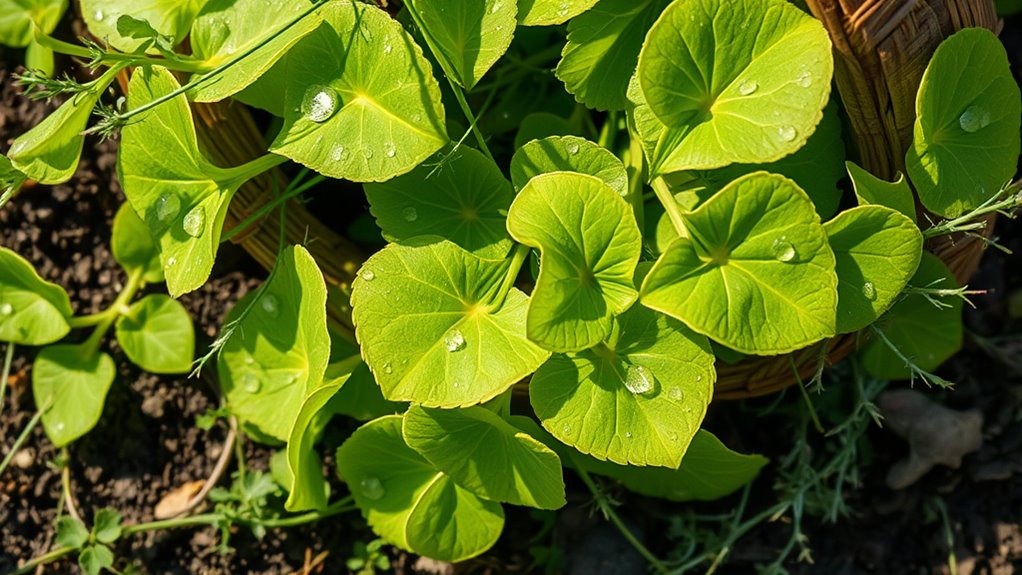
Creative recipes featuring wood sorrel highlight its bright, tangy flavor and versatility in both sweet and savory dishes. You can make an invigorating wood sorrel sorbet by soaking the leaves in boiling water, then blending with simple syrup.
For a zesty starter, try chilled lemony wood sorrel soup with coconut milk, mint, and lemon.
Sauté wood sorrel with butter, lemon juice, and maple syrup for a tasty side.
Use wood sorrel to create a tangy sour grass syrup, perfect for drinks or drizzles.
Incorporate it into mini-cream tarts for a tart, flavorful dessert.
Its lemony taste pairs well with ingredients like maple, coconut, mint, garlic, and herbs.
Additionally, understanding the nutritional benefits of wood sorrel can enhance its use in your culinary creations.
These creative ideas showcase wood sorrel’s culinary potential in both sweet treats and savory dishes.
Frequently Asked Questions
How Do I Differentiate Wood Sorrel From Similar-Looking Plants?
To differentiate wood sorrel from similar plants, start by examining the leaves. You’ll notice the trifoliate leaves with heart-shaped leaflets and a distinct crease, which aren’t present in shamrock or clover.
Use a taste test—wood sorrel has a tart, lemony flavor, unlike others.
Check the flowers’ color and shape, and observe the plant’s growth habits and habitat. These clues help you confidently identify wood sorrel.
Can Wood Sorrel Be Used Medicinally or Topically?
You can definitely use wood sorrel medicinally and topically. Its leaves can be steeped in water to make healing teas, applied as poultices to reduce swelling, or used as juice to treat wounds and skin infections.
Its antibacterial and antioxidant properties help soothe skin conditions like eczema and psoriasis. Plus, it offers internal benefits, such as boosting vitamin C intake and supporting digestive health, making it a versatile natural remedy.
What Are the Best Preservation Methods for Wood Sorrel?
You want to preserve wood sorrel effectively. Start by refrigerating fresh leaves and stems in a sealed container with a damp paper towel to keep moisture.
For longer storage, dry seed pods and store them in airtight containers away from light.
Roots and tubers should be kept in a cool, dark, well-ventilated space.
For extended preservation, use airtight containers in the fridge, checking regularly for spoilage.
Are There Any Specific Pests or Diseases That Affect Wood Sorrel?
You might worry about pests or diseases ruining your harvest. Mealybugs can attack wood sorrel, draining sap and causing yellow leaves.
Fungal issues like black spots or rot can develop if air circulation is poor.
To protect your plants, regularly check for pests, remove infested areas, and make certain good airflow.
Using insecticidal soap and practicing integrated pest management helps keep your wild greens healthy and thriving.
How Does Soil Type Influence the Flavor and Growth of Wood Sorrel?
You might wonder how soil type affects wood sorrel’s flavor and growth. Different soils, like loamy or sandy, influence its density and nutrient availability, which can subtly impact flavor intensity.
Richer, fertile soils promote lush growth, possibly mellowing the lemon taste slightly, while well-drained, less fertile soils may produce more concentrated flavors.
Conclusion
As you venture into the wild, let the gentle tang of wood sorrel guide your senses. With a little care and curiosity, you’ll discover this lemony treasure adds a bright touch to your foraging adventures. Embrace its delicate charm and let it inspire your culinary creativity, turning simple greens into delightful surprises. Remember, nature offers subtle gifts—cherish each find and enjoy the flavorful journey ahead.



